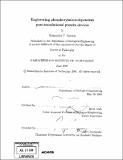Engineering phosphorylation-dependent post-translational protein devices
Author(s)
Sutton, Samantha C. (Samantha Carol)
DownloadFull printable version (34.38Mb)
Other Contributors
Massachusetts Institute of Technology. Biological Engineering Division.
Advisor
Drew Endy.
Terms of use
Metadata
Show full item recordAbstract
One goal underlying synthetic biology is to develop standard biological parts that can be reliably assembled into devices encoding higher-order functions. Here, I developed a framework for engineering post-translational devices, which are devices whose inner workings are modulated by non-covalent protein interactions and covalent protein modifications. To test the framework, I designed a scaffold for engineering post-translational devices in yeast, the Phospholocator, that can be used to assemble peptide parts in order to produce devices that couple upstream kinase activity to regulated nuclear translocation. I used the Phospholocator to design, build, and characterize a Phospholocator device, the Cdc28-Phospholocator, whose location is regulated by the activity of cyclin-dependent kinase Cdc28. I next engineered and tested a Fus3-Phospholocator device, whose location is regulated by the activity of the mitogen-activated protein kinase Fus3, in order to demonstrate that the Phospholocator scaffold supports the engineering of many post-translational devices. I used the Cdc28-Phospholocator to follow Cdc28 activity levels throughout the yeast cell cycle, thereby illustrating the utility of the Cdc28-Phospholocator as a tool for biological inquiry. To implement more complex functions, device engineers will want to connect post-translational devices to build multi-component systems. I thus developed a model for device composition that features a universal signal carrier that is both input into and output from post-translational devices. The universal signal could enable engineers to easily combine devices in any desired order, and thus build many new post-translational systems. (cont.) I next developed a set of specifications and guidelines for designing prototypical protein parts for engineering post-translational devices that communicate via the universal signal carrier. I used the universal signal model and the corresponding set of device specifications to design and model a proof-of-principle. multi-device post-translational system, a post-translational latch, that functions as designed. Taken together, my initial experiences in engineering post-translational devices, defining universal device signals that enable device interconnectivity, and designing, modeling, and analyzing the model of a functional multi-device system, along with the work of many other groups, are sufficiently encouraging to motivate continued work on post-translational devices.
Description
Thesis (Ph. D.)--Massachusetts Institute of Technology, Biological Engineering Division, 2008. Includes bibliographical references (p. 117-127).
Date issued
2008Department
Massachusetts Institute of Technology. Department of Biological EngineeringPublisher
Massachusetts Institute of Technology
Keywords
Biological Engineering Division.